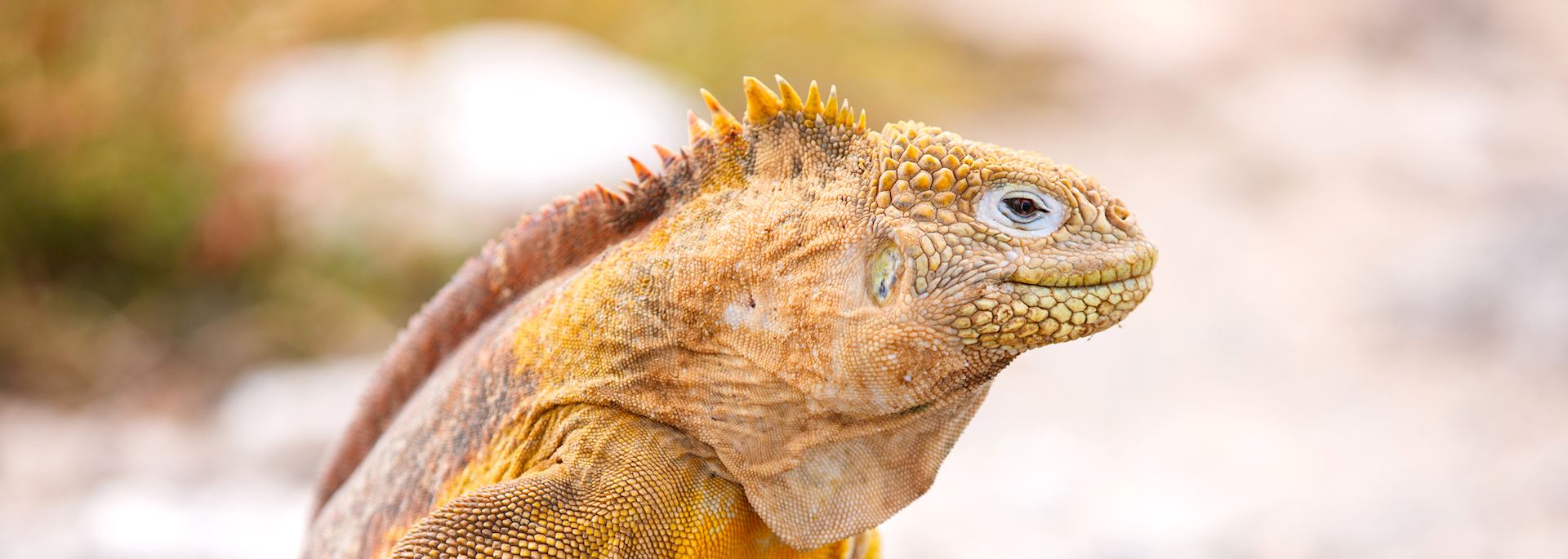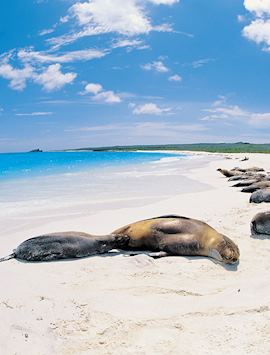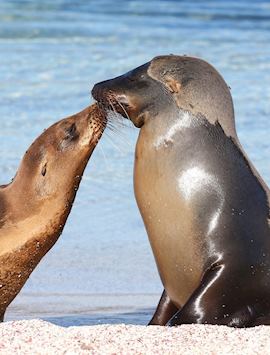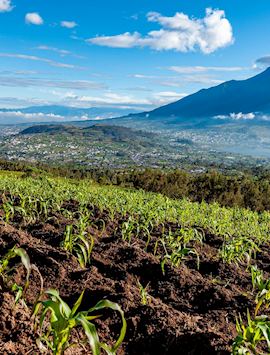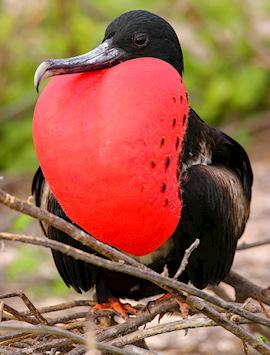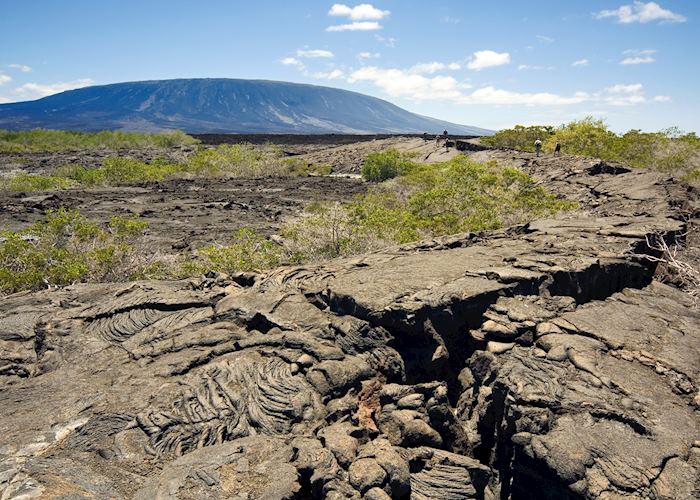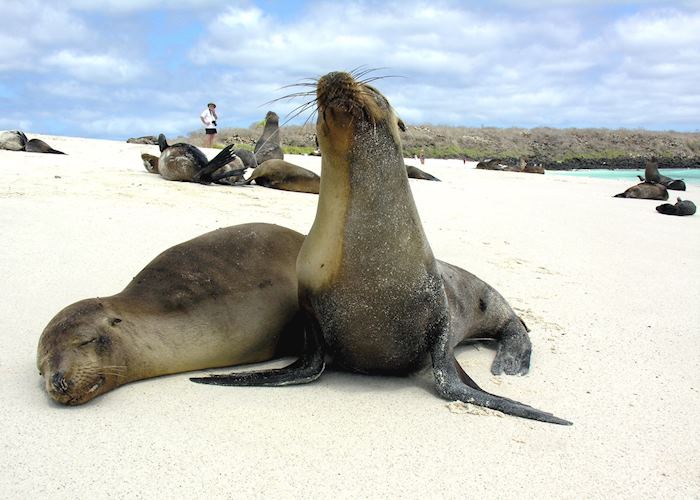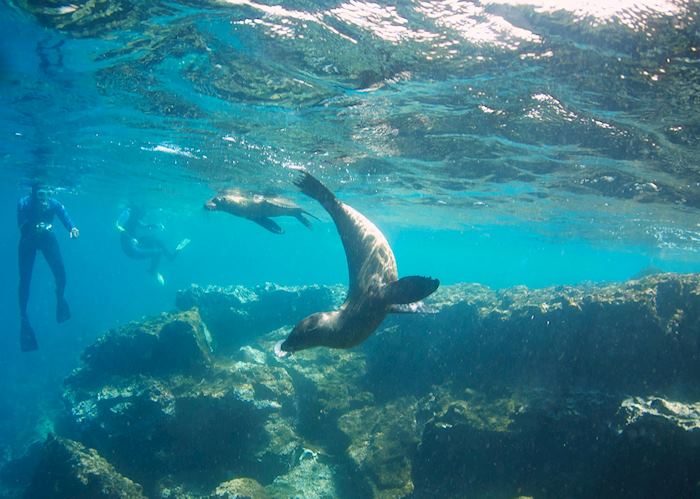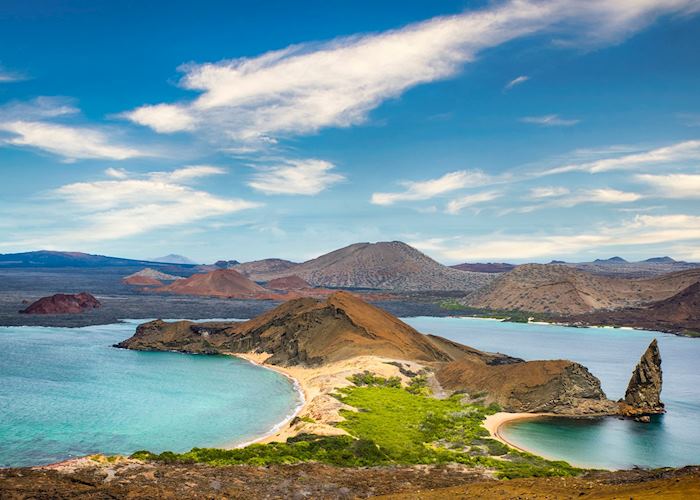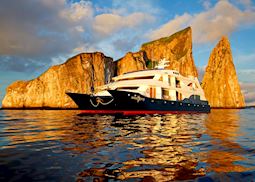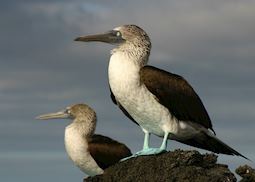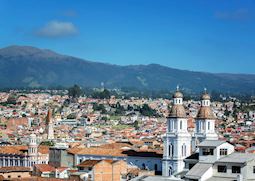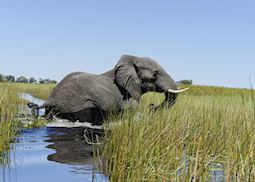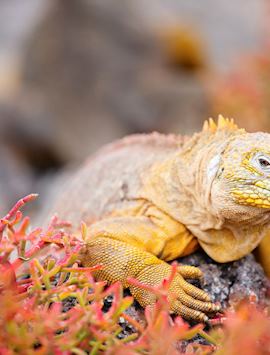
Boulder-like giant tortoises, diving marine iguanas, waved albatrosses taking flight… on a tailor-made holiday to the Galapagos Islands with Audley, you’ll see all their wildlife highlights — and much more — your way. We’ll design your ideal trip with you, paying close attention to your interests, your travel style and your budget. Our Galapagos specialists know the islands and their wildlife inside out, and can lead you to experiences and encounters you won’t find in a guidebook.
Take an adventure cruise around the archipelago, stopping to snorkel in waters brimming with tropical fish and sea turtles. Stroll among sea lions basking on beaches, and hike the cindery caldera of Cerro Negro Volcano. Pass blue-footed, red-footed and masked boobies on a guided walk with a conservation expert: the wildlife here has no fear of humans. Watch frigatebirds’ showy, chest-puffing mating rituals.
The Charles Darwin Research Station. Highland safari camps. The bird-clustered cliffs of remote Genovesa Island, flamingo colonies and mangrove boat trips. What excites you? Travel at your own pace, in your own style, with the confidence that we’ll show you the best options, wherever you go.
Suggested tours for the Galapagos Islands
These tours give you a starting point for what your holiday to the Galapagos Islands could entail. Treat them as inspiration, as each trip is created uniquely for you.
Why travel with Audley?
- 100% tailor-made tours
- Fully protected travel
- Established for over 25 years
- 98% of our clients would recommend us
Best time to visit
Our specialists advise on the best months to visit the Galapagos Islands, including information about climate, events and festivals.
Request our brochure
Covering all seven continents, The World Your Way shows you how you can see the world with us. It features trip ideas from our specialists alongside hand-picked stays and experiences, and introduces our approach to creating meaningful travel experiences.

Useful information for planning your holiday in the Galapagos Islands
The official language of the Galapagos is Spanish, but English is widely spoken in hotels, restaurants, and on board boats.
The official currency of Ecuador, of which the Galapagos is a part, is the US dollar ($). There are some Ecuadorian coins of equivalent value to US coins in circulation. You’ll find ATMs in cities and larger towns, and credit cards are widely accepted, Visa and AMEX more so than Mastercard.
If you’re bringing cash, take small denominations. Many places will not accept notes bigger than a US$20, nor will they accept any notes that are ripped or dirty. It can be difficult to pay with $20 bills as change is often in short supply, so we recommend taking $10 bills and a good supply of $5 and $1 bills too.
In the Galapagos, you should try local fish and seafood dishes such as langostino encocado (lobster cooked in coconut milk) and arroz marinero (rice with seafood). You’ll also find dishes such as ceviche (marinated fish) and sopa marinero (fish soup). Bear in mind that almost all ingredients have to be flown in, so try to avoid imported fish such as salmon when a local alternative might be available. Most hotels and cruises serve an international menu.
Although each boat in the Galapagos has specific tipping guidelines, you’ll usually put the money in an envelope and deposit it in a box, so you can tip as you see fit. Tips are usually pooled and distributed among the guides and crew.
For the latest travel advice for the Galapagos, including entry requirements, health information, and the safety and security situation, please refer to the Foreign, Commonwealth & Development Office website.
In the Galapagos’ fragile ecosystem, it’s important to always keep conservation in mind and take short showers, dispose of all rubbish responsibly, and flush your toilet sparingly. Single-use plastic are banned here so bring a reusable water bottle, and to protect marine species, leave any toiletries or cosmetics containing microbeads at home.
The wildlife here has no natural predators and so appears to be incredibly tame, but always leave 2 m (6.5 ft) between you and any animal and never reach out to touch or feed it. Don’t use your flash when taking photographs, and if you have the time, consider joining a beach clean up while here.
The lure of the Galapagos lies in its astounding variety of wildlife, the close encounters with rare and endemic species, and the volcanic landscapes and untouched bays you’ll explore along the way. Stroll through a colony of grunting sea lions, pause as a boulder-like giant tortoise ambles by, then watch frigate birds inflate their bright red throat pouches to attract a mate.
The wildlife here is fearless and whether you’re watching the courtship dance of a blue-footed booby or the antics of a sneezing marine iguana, you’ll get up close in a way almost impossible anywhere else on Earth.
Expert conservationists will guide your walks along beaches thronged with wildlife or to the cindery rims of volcanic calderas, while in the water you can snorkel or kayak with sea turtles and see shoals of vivid tropical fish swirl about you while bottlenose dolphins race by.
In the Galapagos you can plan a land-based hotel stay or choose to stay on an expedition vessel. On an expedition vessel, you’ll cruise between destinations overnight and see a wider variety of islands, whereas a land-based stay offers more freedom in terms of where to go and when, the option to dine out, and generally larger and more comfortable rooms.
Galapagos cruises take between 14 and 100 passengers and can differ greatly in terms of comfort, cabin size, and on-board facilities, while the range of places to stay on the islands goes from sleek, modern hotels to safari-style tents. For some more ideas, browse our collection of places to stay in the Galapagos or our Galapagos cruise vessels.
With 19 larger islands, it can be difficult to choose where to go in the Galapagos, but most cruises stop at almost all of them, including Santa Cruz, Bartolomé, Genovesa, and Isabela islands. Santa Cruz is the main visitor hub with a good selection of hotels, two volcanic craters, and a giant lava tunnel. You can mountain bike into the highlands and go in search of giant turtles in the mangroves around the white-sand beach at Tortuga Bay.
On Isabela Island you can hike up an active volcano, snorkel with whitetip reef sharks, and visit a tortoise breeding station or flamingo-filled lagoon. Genovesa is renowned for birdwatching, Santa Fé for its iguanas, and Española is a good place to see sea lions, waved albatross, and whitetip reef sharks.
When planning your trip, think about which islands and what species you’d like to see, and your specialist can find the right combination of destinations for you.
A typical day on a Galapagos cruise will involve an early breakfast, followed by two outings, and overnight travel to your next destination. Waking in a new location is always exciting, and your days will combine guided shore outings led by conservation experts with snorkel or kayak trips to see marine life.
A buffet lunch is served on board your vessel between the morning and afternoon outings, and in the evenings there are communal drinks with a talk about that day’s wildlife sightings and a briefing on the following day’s plans, followed by dinner.
A reasonable level of fitness is required for a Galapagos cruise. You’ll be snorkelling two or three times each day, hiking on uneven trails and along sandy beaches, and getting on and off pangas (small inflatable speedboats that take you to the shore), so you’ll need to be fit and mobile enough to do this daily to make the most of your trip.
It takes around 15 hours to fly from the UK to the Galapagos, into Quito via Madrid, Amsterdam or the USA.
The time zone in the Galapagos is UTC-6 hours. Daylight Saving Time isn’t observed here.
The best way to get around the Galapagos Islands is by boat. While on the islands you’ll explore on foot or possibly by mountain bike, but to get between islands you’ll join a cruise, or take a speed boat or ferry. Choosing a Galapagos cruise is a great way to explore, though if you’re short on time, it’s also possible to fly between the main islands.
Use our travel tool to find up-to-date visa and passport requirements for the Galapagos. Enter where you’re travelling to and from (including any stopover destinations en route or flight layovers), along with your intended travel dates and passport details, for a full list of requirements.
Check the latest vaccine advice for the Galapagos with your doctor and ensure you’re up to date with the recommended vaccinations at home. You can also check the suggested vaccinations on the Travel Health Pro website.
The Galapagos Islands in pictures
Our expert guides to travelling in the Galapagos Islands
Written by our specialists from the viewpoint of their own travels, these guides will help you decide on the shape of your own trip to the Galapagos Islands. Aiming to inspire and inform, we share our recommendations for how to appreciate the Galapagos Islands at its best.
-
Planning your Galapagos expedition cruise: how to choose your vessel ![Ocean Spray, Galapagos Islands]()
Planning your Galapagos expedition cruise: how to choose your vessel
Planning your Galapagos expedition cruise: how to choose your vessel
Audley Galapagos specialist Michael details what you need to think about when planning your Galapagos Islands cruise. He gives a brief overview of the different sizes of vessels and the advantages of each, plus what else you should consider.
Read this guide -
A typical day in the Galapagos: what to expect ![Galapagos Islands, Ecuador]()
A typical day in the Galapagos: what to expect
A typical day in the Galapagos: what to expect
Michael, one of our specialists, takes you through what to expect on a visit. He outlines a typical morning, afternoon and evening routine on a cruise boat, and explains the major differences between a cruise and land-based stays.
Read this guide -
What to do in the Galapagos: our highlights guide ![Blue-footed boobies, Galapagos Islands]()
What to do in the Galapagos: our highlights guide
What to do in the Galapagos: our highlights guide
Find out about planning a first time trip to the Galapagos Islands. Embark on a luxury Galapagos cruise to explore the dramatic volcanic brown landscapes and fearless land and marine wildlife of this beautiful archipelago.
Read this guide -
Wildlife highlights of the Galapagos Islands ![Marine iguana, Fernandina Island]()
Wildlife highlights of the Galapagos Islands
Wildlife highlights of the Galapagos Islands
Galapagos specialist Holly shares her top wildlife experiences in the Galapagos Islands. She looks at its unique variety of bird, marine and animal species including giant tortoise, albatross, penguins, sea lions and iguanas.
Read this guide

